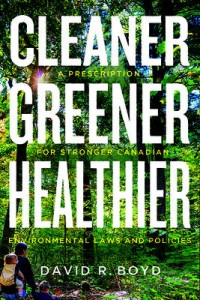User fees make sense. People who want heated parking and water ski lessons could not fairly expect subsidies from non-skiing pedestrians. But what if true costs of goods or services are so deeply hidden no ordinary accounting is possible? This is where Cleaner, Greener, Healthier steps in. Professor David Boyd of Simon Fraser University calculates actual costs of environmental degradation and totes up the bill. The result is arresting.
Take pesticides. On the polluter-pay principle, Sweden taxes imported farm chemicals at $4.75 per kilogram; in Norway the rate is about $4.30. Finland, Denmark, France, Italy – all charge a pesticide tax reflecting the cost of environmental rehabilitation from the long-term effects of chemical use. The tax in Canada is zero. “Even worse, any pesticide used in agriculture regardless of its toxicity is exempt from the federal GST,” writes Boyd. “Rather than discourage the use of pesticides or reflect their substantial negative effects on human health and ecosystems, this subsidy encourages farmers to use pesticides instead of alternative methods of pest control.”
Even the cost of regulating pesticides is heavily subsidized. Health Canada has not increased manufacturers’ licensing fees since 1997. When the department proposed a modest increase in 2015, the Pest Management Regulatory Agency noted fees would still only cover 30 percent of government costs of testing chemicals for toxicity. “If we made our fees too high, it would potentially be a disincentive to industry to enter the Canadian market,” one official told the Senate agriculture committee.
So, manufacturers and farmers draw a fat subsidy for immediate benefit, and everyone else pays the bill. That’s nice work if you can get it.
“Why does Canada lag behind in protecting the health of its citizens from environmental hazards?” Cleaner, Greener asks. “What are the economic, political, legal and cultural factors that explain this systemic failure?”
Professor Boyd blames shrewd lobbying, short-term legislative agendas – and human nature. To drive from Halifax to Vancouver is to see so many lakes and so many trees, simple arithmetic suggests we could poison every lake and cut every tree and still have enough lakes and trees to last a thousand years.
“The chasm between values and actions is that Canadians’ pride in this country’s striking natural beauty, bounty and immensity creates a blind spot about environmental impacts,” Boyd writes; “Canadians consistently express strong environmental values in public opinion polls, but there is a large gulf between their words and their actions. We are among the world’s most prolific consumers of oil, natural gas, electricity and water. Canadians are world leaders in the unenviable categories of household garbage production and per capita emissions of greenhouse gases, sulphur dioxide, nitrogen oxides, carbon monoxide, and volatile organic compounds.”
User fees would mean an asthma tax on Ford Motor Co.; a mercury tax on the Mining Association of Canada; and a groundwater tax on Imperial Oil. Instead regulators concluded environmental impacts are so pervasive, and the cost is so onerous, it’s easier to bury the bills in the accounting of everyday life.
Cleaner, Greener is so candid it’s alarming, so comprehensive it leads the reader to a damning rhetorical question: Why is it Swedes and Norwegians could figure this out, but the Government of Canada is paralyzed by fear of industry?
By Holly Doan
Cleaner, Greener, Healthier: A Prescription For Stronger Canadian Environmental Laws & Policies, by David R. Boyd; University of British Columbia Press; 412 pages; ISBN 9780-7748-30478; $34.95






